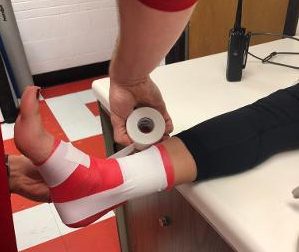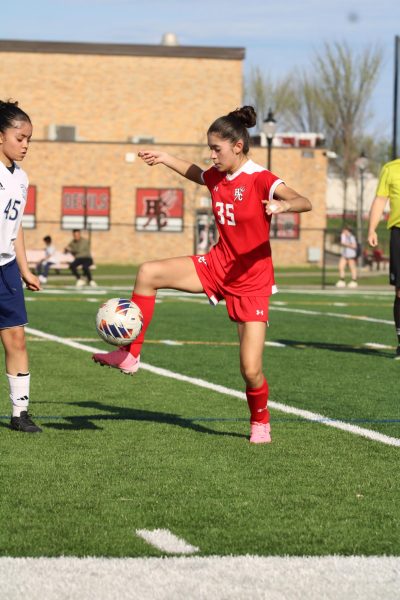Athletes and injuries

Students who have an injury can go see one of the trainers before or after their practice to receive ice or get a body part wrapped due to an injury.
Long distance runner Mac Anderson, senior, loved to run and train with his teammates during the track and cross country seasons. During his junior year, however, Anderson began experiencing growing pains in his knees and shins, diagnosed as Osgood-Schlatter disease. He experienced the pain through his workouts but pushed through it because he would much rather have trained with his friends than go on the dreaded bikes assigned to the injured. Putting stress on his already injured legs, the pain became so bad for Anderson that walking from class to class at school became a torturous task.
High school sports are significant for many students and, in general, at most high schools in the country. Athletes, even those who are in high school, are often highly committed to playing on their team: spending hours training every day and, more importantly, risking being injured.
Injuries are common with every sport but are more specifically related to contact sports or those that are more straining on the body. Every day, around 30 athletes come to the training room to be iced, wrapped, or stretched out. According to the trainers at the school, sports such as football, gymnastics, wrestling, cheerleading, and track cause many injuries for their athletes. Concussions, shin splints, ACL tears, bruises, bumps, and broken bones are all things that students have commonly experienced as a result of competing in a sport, and yet the majority of students continue to play.
Many side effects to playing sports have been reported, with one of the more infamous being of former tight end for the New England Patriots Aaron Hernandez, who after having been arrested for murder, was diagnosed with chronic traumatic encephalopathy (CTE). This disease has been found in numerous NFL players and linked to countless blows to the head, and its symptoms include violent mood swings and aggression. While in most cases CTE patients don’t react in such an extreme manner, Hernandez was at one of the most severe stages for someone his age.

Aaron Hernandez, NFL tight end, suffered from an extreme case of CTE from playing football.
While many activities have risks, research shows that playing sports when injured is dangerous.
For most students, it’s not that they don’t understand that the pain isn’t normal, it’s the fact that they know what they will be told to do if they are open about it: “You will have to take some time off to let it heal.” These are the dreaded words that ring bells in the ears of the school’s competitive athletes.
“[Students don’t respond well to that advice] mainly because as an athlete you want to be part of what goes on and be a part of the team,” said Ms. Liz Wohrley, school athletic trainer. “Sitting out and watching is not fun, I remember from my time as an athlete. You get depressed about not being able to do anything, so that’s one of the reasons why lots of athletes try to push through it.”
Coaches can also be a huge part of athletes’ decisions to stay in the dark or push through pain that will worsen their injury. Many athletes agreed that being on a team at this school can be a lot of pressure because, as a school, sports aren’t taken lightly.
“I’ve had coaches throughout my whole career try to convince athletes that they are fine and they can return playing,” Ms. Wohrley said. “When I realize [the athlete] is pushing themselves, I would step in and say they cannot return.”
However, athletes were quick to recognize how many of their coaches also look out for injuries and encourage rest and recovery.
“It’s very important for athletes to warm up before and stretch after workouts. If I notice that one of my athletes is in pain or has an injury, I will tell them to stop training, ” said Mr. Pat Richards, who coaches boys football and girls track and field. “There are definitely a lot of athletes that hide the fact that they are injured because they want to keep competing, but it’s important for them to realize that it is going to make their performance worse.”
In recent years, the school has taken many steps to ensure the athletic program educates players about the dangers of injury. Before the start of the fall, winter, and spring sports the Athletic Department holds a mandatory meeting for athletes which informs them about the symptoms of concussions and the importance of alerting someone if those symptoms apply to you.
In the opinion of the trainers, however, more education on the difference between being hurt and being injured should be given to athletes at the start of their seasons or by their coaches so that they realize the risks that could fall upon them.
Anderson ultimately realized the danger he was putting himself in and gave in to treatment. Once he started going to physical therapy and slowing his pace during workouts, his injury healed itself and this year, during his cross country season, he didn’t experience any pain or injury.

Hajera Naveed is a Senior Writer and Section Editor for Devils' Advocate. Her hobbies include writing, volunteering, painting, and running. When she isn't...













